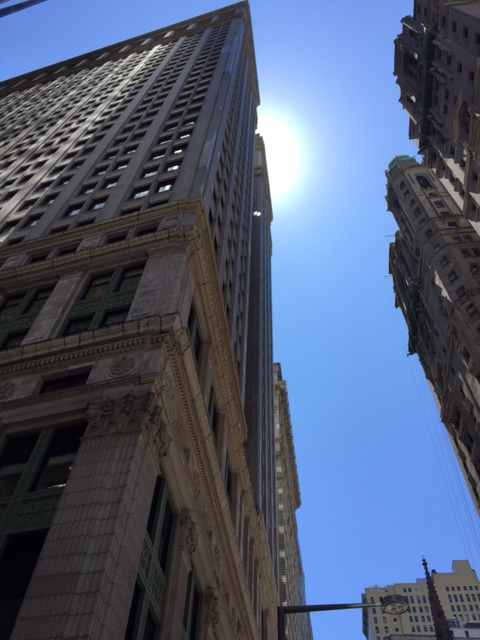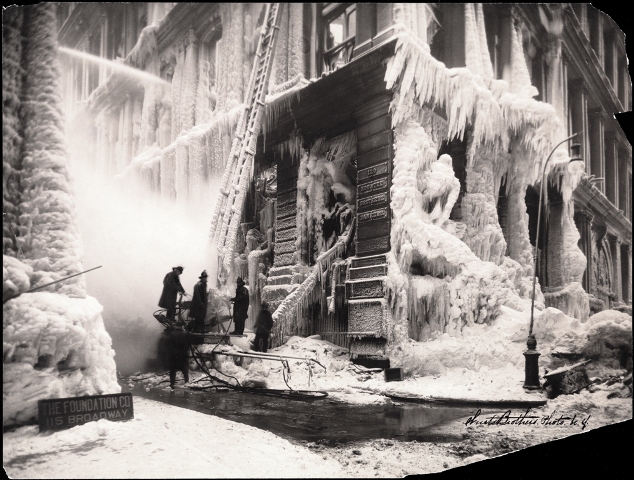
On January 9, 1912, just after 5 a.m., a careless worker tossed a lit match into a rubbish can in the basement of 12 Pine Street, located in the Equitable Life Building on Broadway at Cedar and Pine streets. Four hours later, when the fire was finally contained, six men, including two firefighters, were dead, and the once formidable Equitable Life Building was nothing more than a shell coated in thick ice.
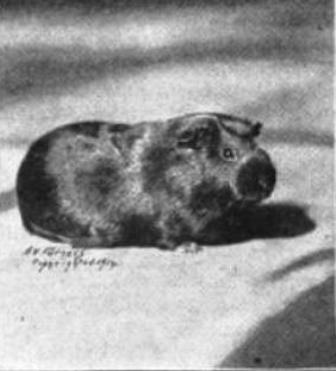
Two weeks after the fire, workmen who were trying to salvage the contents of the cellar vaults and safe boxes rescued a cat named Kaiser. But the cat wasn’t the only animal that had survived the fire.
A black guinea pig later named Miss Bacillus was also discovered during the salvage operation.
Somehow, the poor guinea pig had survived 16 days in the extreme cold, imprisoned in a small cage without any food or water.
Miss Bacillus had been brought to the Equitable Life Building by Dr. A.S. Wolf, who had an office on the third floor of the Pine Street side of the building. Dr. Wolf was reportedly conducting some “experiments” with the guinea pig for medical insurance purposes. (Dr. Wolf seems an appropriate name if this is true.)
Although this part of the building had not been destroyed by the fire, the office had been completely damaged by water and ice, and so no one thought to look in the room for survivors, human or otherwise. It wasn’t until Dr. Wolf heard a very faint squeak while recovering personal items from his office that the guinea pig was discovered.

Dr. Wolf let the guinea pig out of her cage, and she immediately scampered across the office to where he stored her food. When he brought her back outside, hundreds of people who were waiting their turn to go into the building to retrieve their contents from the safe deposit boxes gathered around the cage in awe.
Dr.Wolf turned out to be a pretty good guy. He reportedly gave his guinea pig to Henry W. Ward of Washington, D.C., whose young son was mourning the recent loss of his pet guinea pig. In March 1912, Mr. Ward brought their new pet back to New York City, where “Miss Bacillus” shared the spotlight with Kaiser the Faithful cat at the Woman’s Industrial Exhibition.

A Look Back on Broadway at Pine and Cedar Streets
The acre of land on which the Equitable Life Building was constructed was previously just a small portion of a large farm owned by an early Dutch settler and trader named Jan Janszen Damen (or Dam). Jan Damen acquired the property through a Dutch land grant in 1644 from Governor William Kieft — just 9 years before the “great wall” was built.
The rolling property extended from present-day Pine Street to Fulton Street on the west side of Broadway, and from Pine Street to Maiden Lane east of Broadway.

Jan Damen erected a large farmhouse (the “great house”), a few outbuildings, and a “small house” on Heere Straat just north of what we call Wall Street. The great house was near the corner of today’s Cedar Street, and the small house occupied what is now Pine Street and Broadway.
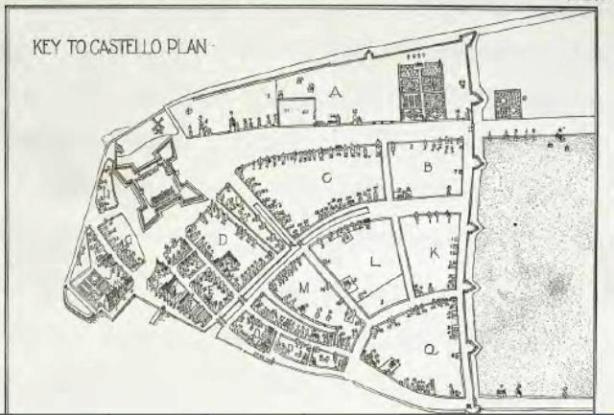
According to the Key to the Castello Plan, “The great house stood diagonally across Cedar Street, on Broadway. If it could be reconstructed today, its south corner would probably touch the…Equitable Life Building.”
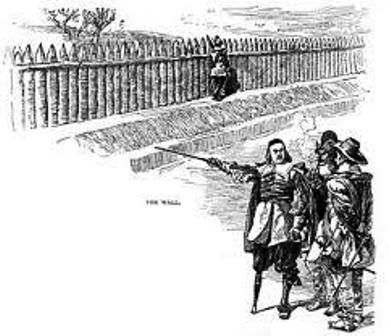
Following Damen’s death in 1651, his land was conveyed to his widow and her heirs. Two years later the city — under the command of Peter Stuyvesant — erected a 12-foot tall stockade across the entire island to fend off attacks from Native American tribes.
In 1672, the Damen heirs sold the farmhouse to Dr. Henry Taylor. Their timing was perfect: A year later, the city ordered Dr. Taylor and all the other property owners north of the wall to demolish their homes because they were thought to be impeding the city’s walled defenses.
The Tulip Garden
In November 1664, Damen’s smaller house was purchased by Pieter Van Stoutenburg (aka Peter Stoutenburgh), another Dutch settler who came to New Amsterdam sometime around 1638. Stoutenburgh was at one time the city’s horticulturist, and is credited with bringing the first tulip bulbs to New Amsterdam. His half-acre tulip garden between present-day Nassau Street and Broadway was quite an attraction in those days.
In 1673, Peter Stoutenburgh was also ordered to demolish his home because it was too close to the great wall. However, Peter held onto the land until his death in 1699, when it was conveyed to his heirs.
Sometime during the early 1700s, the Stoutenburgh estate sold the former tulip garden property to the Dutch Reformed Church. The church constructed a parsonage on the site, which served as a residence for the minister of the Middle Dutch Church on Nassau Street between Cedar and Liberty Streets.
The Vauxhall Garden
Fast-forward about 60 years to 1797, when Jacque Madelaine Joseph De La Croix (aka Delacroix), a French caterer and confectioner, purchased the 37 x 140 foot parsonage plot from the Dutch Church for 3,950 pounds (less than $10,000). According to Delacrox, this was “a remarkable lot and large house…with large stone cistern, a very large ice house, handsome water works, and a fine garden of fruit trees.”

Delacroix established a confectionery shop in the old parsonage at 112 Broadway, which he shared with John and M Paff, dealers in musical instruments. Behind the shop, he created a pleasure garden called Ice House Garden (later, Vauxhall Garden).
Opened on July 4, 1797, the garden was a popular resort that featured light refreshments and simple entertainment, including vocal and instrumental concerts. The admittance fee was 6 shillings, which included a glass of ice cream and punch or lemonade.
In 1825, Delacroix enlarged his shop at 112 Broadway to create the National Hotel (112-114 Broadway). Just next door, at 110 Broadway, was the Tremont Temperance House hotel. The New York Athenaeum, established in 1824, was on the corner of Broadway and Pine (from 1821-22, William Cullen Bryant edited the New York Review and Athenaeum in a building on this site). And at 120 Broadway, on the corner of Cedar, Francis Guerin, a celebrated restaurateur, operated a shop that was famous for its French cordials, bonbons, preserves, tarts, and confections.
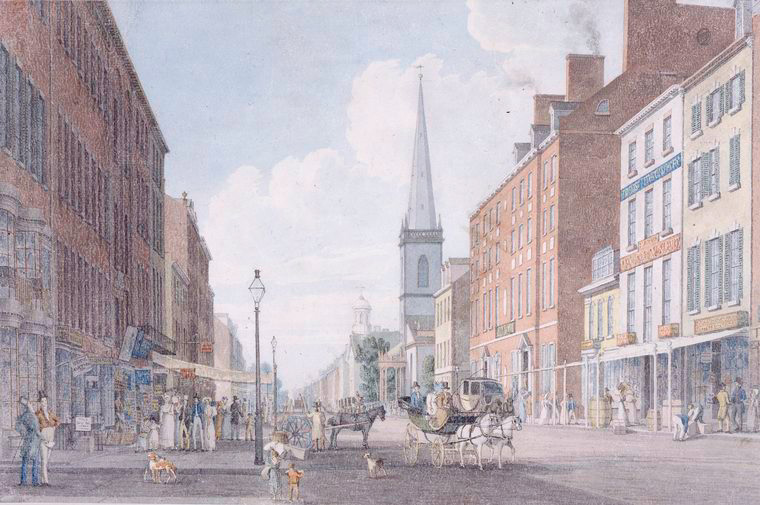
In 1836, Delacroix sold the National Hotel to Charles St. John for $100,000. Sometime between then and 1867, the hotel was conveyed to General Daniel Butterfield, the son of John Butterfield, a founder of the American Express Company.
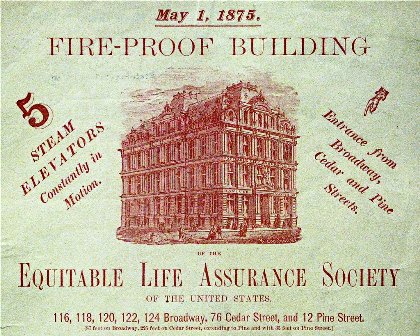
The Equitable Life Assurance Society Steps In
In 1866, The Equitable Life Assurance Society purchased No. 116 and 118 Broadway, and in 1867, they purchased No. 120 from the American Express Company for $300.000. It was on this site that the original Equitable Life Building was constructed in 1870. This white granite building was six stories and had two steam-driven passenger lifts.
Gradually, the Equitable purchased additional parcels, including No. 112-114 — which they acquired in 1876 from Butterfield for just under $303,000 — No. 12 Pine Street, and a 50-foot plot at Broadway and Pine, which they bought from the Metropolitan National Bank in 1885 for just over $760.000. After getting control of the entire block — called the Equitable Block — additions and improvements were made to the building.
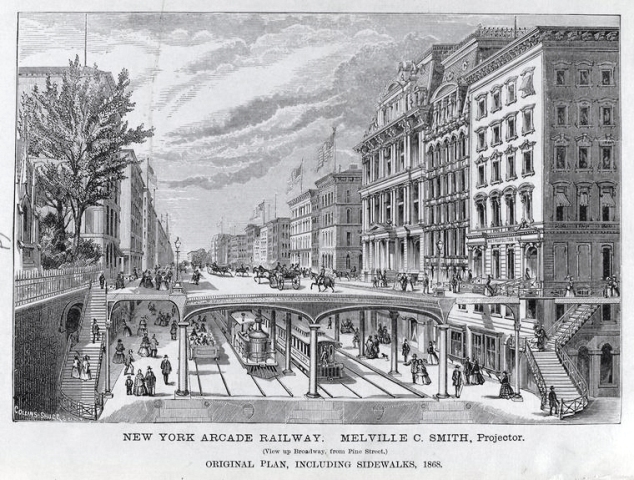
Life After the Equitable Life Fire
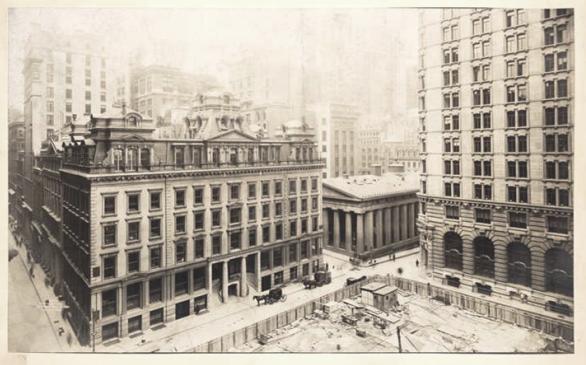
In November 1912, ten months after the great fire, several leading bankers proposed turning the site of the former Equitable Life Building into a public park. At the same time, the Du Pont company was plotting to construct a 36-story building on the site.
Eventually, plans were approved for a new 36-story Equitable Building, which was constructed in 1913 on the same site. Noting its fireproof elevator shafts and doors, the president of the contractors said “the new Equitable Building will be the nearest to an absolutely fireproof building in the world.”

